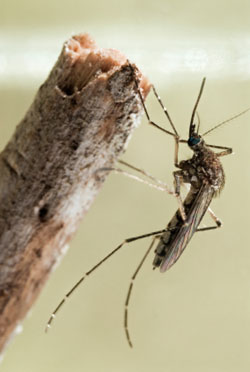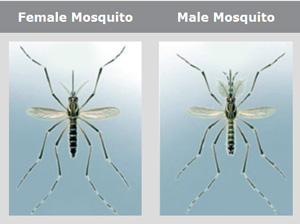Tiny Mosquito
Introduction to the Mosquito
The word “mosquito” is Spanish for “little fly”. And while the insect may be small, it is well known for its big, itchy bite.
 Mosquitoes
are summertime pests. They ruin barbecues, late
night strolls by the lake, and quiet evenings
relaxing on the porch. The annoying sound of
the bug zapper or the unpleasant smell of insect
repellent is enough to turn any fun outdoor
evening event into a sheltered indoor activity.
Mosquitoes lurk around looking for a human or
animal “host” from which they can
suck blood. Their bites are very itchy and can
leave the skin irritated for a few days.
Mosquitoes
are summertime pests. They ruin barbecues, late
night strolls by the lake, and quiet evenings
relaxing on the porch. The annoying sound of
the bug zapper or the unpleasant smell of insect
repellent is enough to turn any fun outdoor
evening event into a sheltered indoor activity.
Mosquitoes lurk around looking for a human or
animal “host” from which they can
suck blood. Their bites are very itchy and can
leave the skin irritated for a few days.
Mosquitoes, however, are more than just a summertime nuisance. Some carry dangerous diseases that are transmittable to humans. These diseases include West Nile virus (also see our article about The History of West Nile Virus), malaria, encephalitis, and dengue fever.
What do they look like?
There are over 2,700 different species of mosquitoes buzzing throughout the world. These insects are generally ¼ to ½ inch long and brown in color. They are thin, long-legged, and winged.
Where do they live?
Mosquitoes breed in stagnant water and therefore, their habitats are usually found near lakes and ponds. They may also live closer to your home than you would like. They have been found in clogged gutters, old tires filled with water, fountains, and swimming pools that are not chlorinated.
Did you know…?
Many would be interested to know that only the female mosquito sucks blood. They need the proteins found in animal and human blood to reproduce. The males, on the other hand, get their nourishment from plant nectars.
-
Browse through the rest of the site to learn about:Do you recognize the difference between male mosquitoes and female mosquitoes? See here for more.
- Different species of mosquitoes
- Treating mosquito bites
- Protecting yourself against mosquitoes
- Diseases carried by mosquitoes
- Mosquito Facts and Myths
Articles of Interest:
The History of the
West Nile Virus
Mosquito Prevention
The Buzz on Malaria Symptoms
Mosquito Netting Canopy:
Your Best Defense
The Mosquito Life Cycle
Natural Mosquito
Control - What is it?
Mosquitoes
Developing Stronger Defences to Insecticide
Relieve
the Itch with a Mosquito Bite Remedy
Mosquito Screen Patio
Mosquito Allergies
- A Biting pain
Green Mosquito Control
Products: Safe Ways to Get Rid of Pests
Home - Mosquitoes - Bites - Control - Diseases - Resources - Site Map
